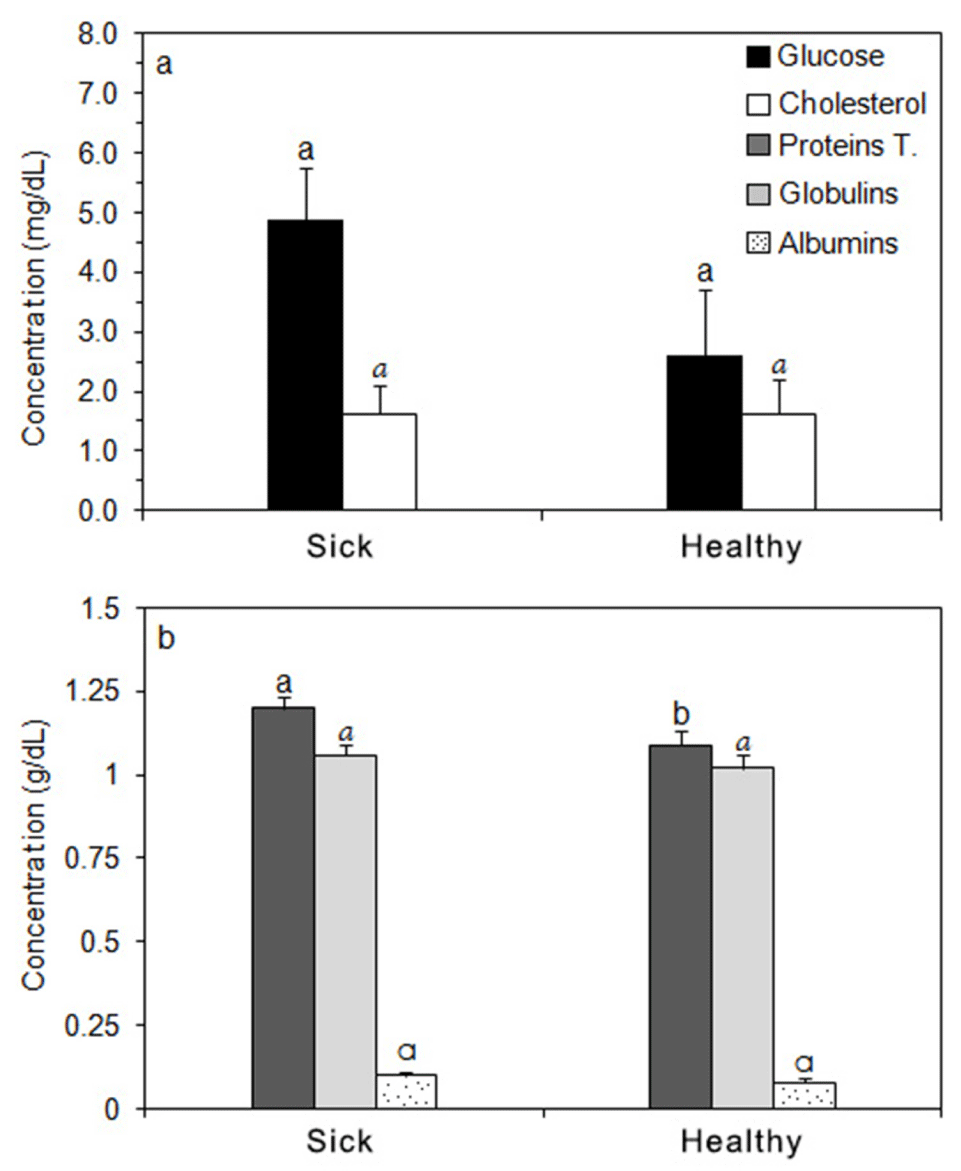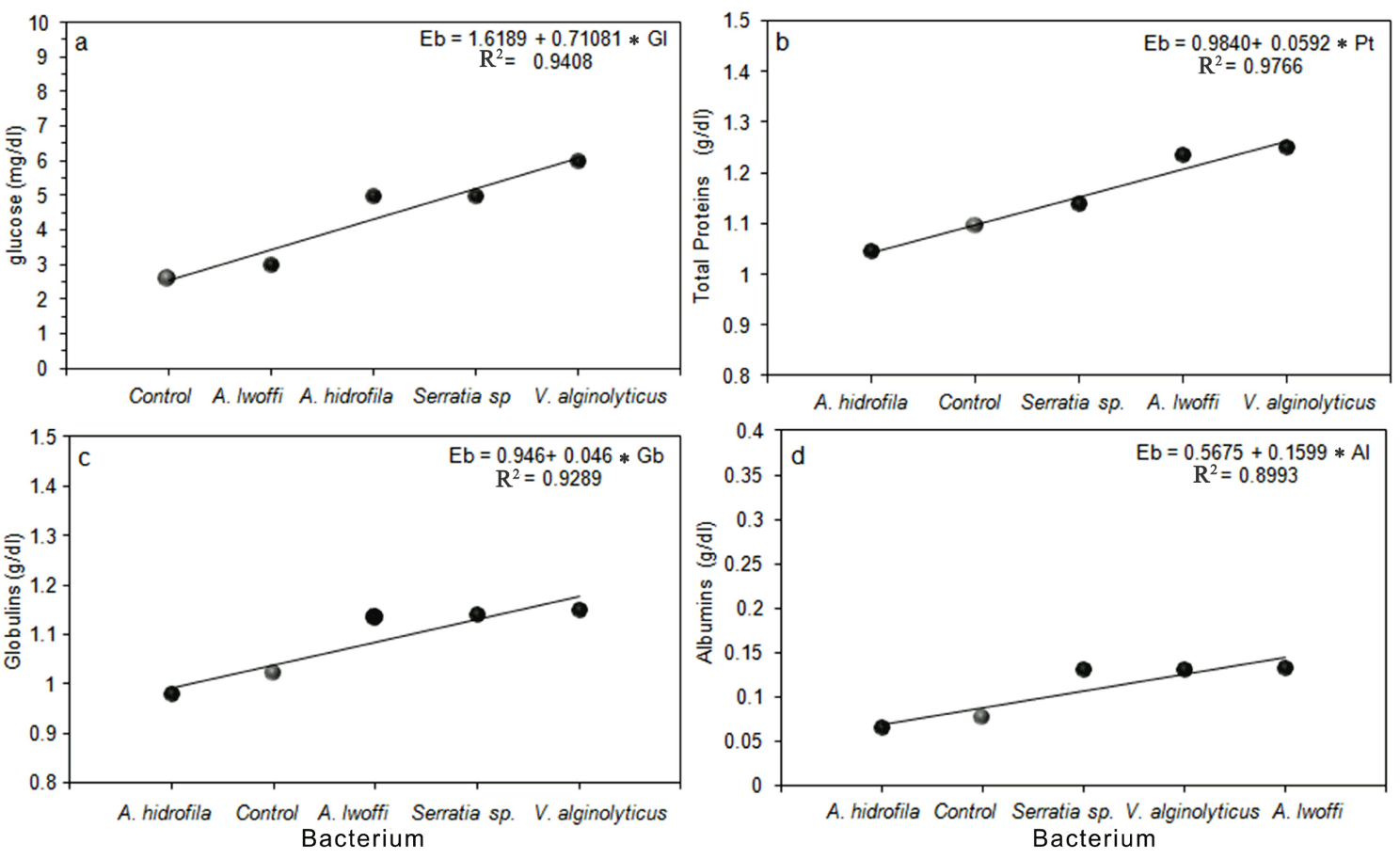Biology Group. 2023 September 30;4(9):1370-1373. doi: 10.37871/jbres1805.
Pathogenic Bacteria and their Effect on Plasma Components of Haliotis fulgens (Archaeogastropoda: Haliotidae) in Baja California Sur, Mexico
Liliana Carvalho-Saucedo1* and José Luis Gutiérrez González2
2Instituto Nacional de Pesca. Pitágoras 1320, Col. Santa Cruz Atoyac, Delegación Benito Juárez, Cd. de 03310, México
- Bacterial infection
- Diseased abalone
- Serum hemolymp
- Biochemical compounds
Abstract
Background: In Mexico Haliotis fulgens catch decreased considerably in 2012. In other countries like U.S.A., Australia, and Tasmania, their decline was associated with death by pathogens. Goals. We studied the bacterial effect on the concentration of some biochemical components of haemolymph of H. fulgens.
Methods: Eight apparently sick abalone of culture and five healthy abalone were collected in 2013. The concentration of glucose, total proteins, albumin, globulins, and bacterial species were obtained.
Results: We found Vibrio alginolyticus, Acinetobacter lwoffii, Serratia sp. y Aeromonas hydrophila. The diseased abalone had a higher total protein concentration than the healthy abalone (1.20 g/dl and 1.09 g/dl, p < 0.05, respectively). The increase of glucose, total proteins, globulins, and albumins was directly proportional with bacterial effect.
Conclusion: This is the first report of V. alginolyticus, A. lwoffii, Serratia sp. y A. hydrophila in H. fulgens, cultivated in La Boca, Baja California Sur, Mexico. A regression analysis showed a negative effect on the biochemical components of hemolymph due to these bacteria.
Introduction
In Mexico, the catch of abalone Haliotis fulgens decreased considerably in 2012 [1]. Some researchers point out that the mortality of Haliotis on the coasts of the United States was associated with an infectious phenomenon [2]. In Tasmania and Australia, the presence of Vibrio harveyi, caused losses in the crops of Haliotis rubra and Haliotis laevigata [3]. In particular, the Haliotis genus has an immune system activated by the entry of foreign agents [4]. Until now, the effect of pathogens on the concentration of serum components has not been demonstrated in abalone, cultivated in La Boca, Baja California Sur, and Mexico. Therefore, the present work studied the bacterial effect on the concentration of some biochemical components of the hemolymph of blue abalone H. fulgens.
Materials and Methods
In La Boca, Baja California Sur, Mexico (26° 3' 45''N, 112° 17'12'' W) in 2013, an anomalous mortality was observed in a culture tank for fattening H. fulgens. The organisms came from culture tanks (5000 L), with seawater, filtered and irradiated with Ultraviolet (UV) light, oxygenated, temperature of 17 ± 2°C, and fed with natural food (Eisenia arborea). Eight presumably sick baby abalone were collected; from another tank five apparently healthy abalones were collected as a control group. Approximately 2.5 ± 0.5 ml of foot hemolymph was extracted from each organism. The bacterial analysis was performed by culture on blood agar plates (agarose), Tryptone Soy Agar, 3% saline Tryptone Soy Agar and Thiosulfate Citrate Agar medium Bile Salts Sucrose. Bacterial identification was performed with a commercial kit (BBL Crystal, USA) following the manufacturer's instructions [5]. The levels of glucose (mg/dl), cholesterol (mg/dl), total proteins (g/dl), albumin (g/dl) and globulins (g/dl) in hemolymph were performed with commercial packages for serum examination (Randox, Laboratories Ltd., USA). The A/G ratio was calculated by: A/G ration = Albumin/ lobulin values.
Normality was verified with the Kolmogorov-Smirnov test and homogeneity of variance with Chi square. A one-way analysis of variance (ANOVA) was performed for each biochemical component between sick and healthy patients; between albumins and globulins of the sick and healthy; and by type of bacteria. Where there were differences, the Dunnett tests were used (p = 0.05), the data were analyzed by using the software Statistica StatSoft versión. Regression tests were used between the concentration of each biochemical component in healthy organisms (control) and bacterial presence to verify the Bacterial effect (Eb).
Results and Discussion
The results showed in diseased abalones the presence of Vibrio alginolyticus, Acinetobacter lwoffii, Serratia sp., and Aeromonas hydrophila. There were no cases with more than two bacterial species in the same mollusk. No effect was observed on cholesterol concentration between sick (1.63 mg/dl) and healthy (1.6 mg/dl) patients. In the diseased abalones there was an increase of glucose (4.86 mg/dl), albumins (0.10 g/dl) and globulins (1.10 g/dl), compared to healthy organisms (glucose = 2.60 g/dl, albumin = 0.08 g/dl; globulins = 1.02 g/dl), but not significant (Figures 1a,b). There was more total protein in sick people than in healthy people (1.20 g/dl and 1.09 g/dl, Dunnett, p < 0.05) (Figure 1b). In Haliotis fulgens there is only one study on the levels of glucose and total proteins in hemolymph in which the increase in proteins and glucose was observed with increasing hypoxia stress [6]. Therefore, the increase in total protein and the trend of increased glucose in the hemolymph of H. fulgens was caused by the bacterial infection.
In mollusks, little is known about serum globulins and albumins. In Pinctada radiata it has been seen that the concentration of albumins and globulins are altered in contaminated environments [7]. In H. fulgens the A/G ratio found was low, in healthy (0.08) and diseased (0.09) abalone. It has been shown that albumin concentration is considerably lower in marine than freshwater fish [8]. Although we do not have a reference for abalone, the similar A/G ratio of healthy and sick individuals indicates that the low A/G ratio is a characteristic of H. fulgens that can be taken as a reference for future studies.
The bacterial analysis showed that the concentration of total proteins (1.25 g/dl, Dunnett, p < 0.05) in abalones with V. alginolyticus was higher than that of healthy organisms (1.09 g/dl, Dunnett, p < 0.05). Regression analysis showed an increase in glucose (R2 = 0.9408) in the presence of V. alginolyticus, A. hydrofila and Serratia sp; and the increase in total proteins (R2 = 0.9766), globulins (R2 = 0.9289) and albumins (R2 = 0.8993) with V. alginolyticus, A. lwoffii and Serratia sp. (Figure 2a-d).
We can say that these bacteria had the ability to cause a negative effect on the biochemical metabolism of Haliotis fulgens, and V. alginolyticus had a more obvious effect on proteins. In H. fulgens, as has been reported in vertebrates, the increase in serum proteins seems to be associated with infectious events [9]. It has been seen that Aeromonas spp. and V. alginolyticus are capable to cause high mortalities in mollusk, shrimp, and fish cultures, in Serratia sp. damage to cephalopods and oysters [10,11]. In the genus Haliotis, there is only one report of infection by V. alginolyticus in Haliotis diversicolor, and in H. rufescens [12,13], but until now there are no reports of the presence of V. alginolyticus, Serratia sp., A. lwoffii, A. hydrophila in Haliotis fulgens. This study reports for the first time in H. fulgens the presence of V. alginolyticus, Serratia sp., A. lwoffii, A. hydrophila, which had an adverse effect on the concentration of its serum components. However, to establish a more accurate diagnosis and treatment of the metabolic condition of H. fulgens, based on the plasma components, it is necessary to continue with studies to establish the normal ranges of the values of glucose, cholesterol, and total proteins (albumin and globulins) in hemolymph, in healthy organisms with different ages, as well as in abalone in reproductive activity and inactivity. It is important to highlight that the analysis of hemolymph as part of health monitoring avoids the sacrifice of organisms for diagnosis, which results in an economic benefit for producers, since this resource has a high cost in the market [14].
Conclusion
In conclusion, we can say that the bacteria V. alginolyticus, Serratia sp, A. lwoffii increased glucose and total proteins in the hemolymph of Haliotis fulgens.
Acknowledgment
To the Oc. Daniel Aguilar Osuna of the Sociedad Cooperativa de Produccion Pesquera, S.A. of C-V. “Progress” for the donation of copies. To the Special Analysis Laboratory, Arari Group of B.C.S, SA of CV for access to its facilities.
References
- Ponce-Díaz G, Lluch-Cota SE, Bautista-Romero JJ, Lluch-Belda D. Caracterización multiescala de la temperatura del mar en una zona de bancos de abulón (Haliotis spp.) en Bahía Asunción, Baja California Sur, México. Ciencias Marinas. 2003;29(3):291-303.
- Lafferty KD, Kuris AM. Mass mortality of abalone, Haliotis cracherodii, on the California Channel Islands: Tests of epidemiological hypotheses. Marine Ecology Progress Series. 1993;96:239-248. doi: 10.3354/meps096239.
- Handlinger J, Carson J, Donachie L, Gabor L, Taylor D. Bacterial infection in Tasmanian farmed abalone: Causes, pathology, farm factors and control options. In: Walker P, Lester R, Bondad-Reantaso MG, editors. Diseases in Asian Aquaculture V. Fish Health Section. Asian Fisheries Society: Manila; 2005. p.289-299.
- Donaghy L, Hong HK, Lambert C, Park HS, Shim WJ, Choi KS. First characterisation of the populations and immune-related activities of hemocytes from two edible gastropod species, the disk abalone, Haliotis discus discus and the spiny top shell, Turbo cornutus. Fish Shellfish Immunol. 2010 Jan;28(1):87-97. doi: 10.1016/j.fsi.2009.10.006. Epub 2009 Oct 12. PMID: 19822215.
- Najiah M, Nadirah M, Lee KL, Lee SW, Wendy W, Ruhil HH, Nurul FA. Bacteria flora and heavy metals in cultivated oysters Crassostrea iredalei of Setiu Wetland, East Coast Peninsular Malaysia. Vet Res Commun. 2008 Jun;32(5):377-81. doi: 10.1007/s11259-008-9045-y. Epub 2008 Mar 28. PMID: 18369732.
- Calderón-Liévanos S. Respuesta fisiológica del abulón azúl (Haliotis fulgens, Philippi 1845) por efecto combinado de Hipoxia y estrés térmico, (Tesis Maestría). México: Centro de Investigaciones Biológicas del Noroeste. 2015.
- Abdul-Aziz KK. The health status and genetic variations of the bivalve, Pinctala radiate affected by environmental pollution. Journal of Environmental & Analytical Toxicology. 2012;2:138-145. doi: 10.4172/2161-0525.1000138.
- Andreeva AM. Structure of fish serum albumins. Journal of Evolutionary Biochemistry and Physiology. 2010;46(2):135-144. doi: 10.1134/S0022093010020018.
- Urquizo Ayala G, Arteaga Coariti R. Proteína C reactiva en el diagnóstico y pronóstico de enfermedades infecciosas en pacientes geriátricos. Rev Méd. 2017;23(2):69-73.
- Defoirdt T, Boon N, Bossier P, Verstraete W. Disruption of bacterial quorum sensing: An unexplored strategy to fight infections in aquaculture. Aquaculture. 2004;240:69-88. doi: 10.1016/j.aquaculture.2004.06.031.
- Romalde JL. Héroes o villanos: Bacterias asociadas a los cultivos de moluscos. Revista AquaTIC. 2012;37:45-59.
- Lee KK, Liu PC, Chen CY, Huang CY. The implication of ambient temperature with outbreak of vibriosis in cultured small abalone, Haliotis diversicolor supertexta Lischke. Journal of Thermal Biology. 2001;26:585-587. doi: 10.1016/S0306-4565(01)00004-3.
- Anguiano-Beltrán C, Lizárraga-Partida ML, Searcy-Bernal R. Effect of Vibrio alginolyticus on larval survival of the blue mussel Mytilus galloprovincialis. Dis Aquat Organ. 2004 May 5;59(2):119-23. doi: 10.3354/dao059119. PMID: 15212277.
- Travers MA, Le Goïc N, Huchette S, Koken M, Paillard C. Summer immune depression associated with increased susceptibility of the European abalone, Haliotis tuberculata to Vibrio harveyi infection. Fish Shellfish Immunol. 2008 Dec;25(6):800-8. doi: 10.1016/j.fsi.2008.08.003. Epub 2008 Aug 22. PMID: 18786640.
Content Alerts
SignUp to our
Content alerts.
 This work is licensed under a Creative Commons Attribution 4.0 International License.
This work is licensed under a Creative Commons Attribution 4.0 International License.










